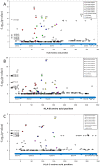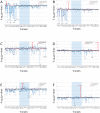The principal genetic determinants for nasopharyngeal carcinoma in China involve the HLA class I antigen recognition groove
- PMID: 23209447
- PMCID: PMC3510037
- DOI: 10.1371/journal.pgen.1003103
The principal genetic determinants for nasopharyngeal carcinoma in China involve the HLA class I antigen recognition groove
Abstract
Nasopharyngeal carcinoma (NPC) is an epithelial malignancy facilitated by Epstein-Barr Virus infection. Here we resolve the major genetic influences for NPC incidence using a genome-wide association study (GWAS), independent cohort replication, and high-resolution molecular HLA class I gene typing including 4,055 study participants from the Guangxi Zhuang Autonomous Region and Guangdong province of southern China. We detect and replicate strong association signals involving SNPs, HLA alleles, and amino acid (aa) variants across the major histocompatibility complex-HLA-A, HLA -B, and HLA -C class I genes (P(HLA-A-aa-site-62) = 7.4 × 10(-29); P (HLA-B-aa-site-116) = 6.5 × 10(-19); P (HLA-C-aa-site-156) = 6.8 × 10(-8) respectively). Over 250 NPC-HLA associated variants within HLA were analyzed in concert to resolve separate and largely independent HLA-A, -B, and -C gene influences. Multivariate logistical regression analysis collapsed significant associations in adjacent genes spanning 500 kb (OR2H1, GABBR1, HLA-F, and HCG9) as proxies for peptide binding motifs carried by HLA- A*11:01. A similar analysis resolved an independent association signal driven by HLA-B*13:01, B*38:02, and B*55:02 alleles together. NPC resistance alleles carrying the strongly associated amino acid variants implicate specific class I peptide recognition motifs in HLA-A and -B peptide binding groove as conferring strong genetic influence on the development of NPC in China.
Conflict of interest statement
The authors have declared that no competing interests exist.
Figures



References
-
- Jemal A, Bray F, Center MM, Ferlay J, Ward E, et al. (2011) Global cancer statistics. CA Cancer J Clin 61: 69–90. - PubMed
-
- Henle G, Henle W (1976) Epstein-Barr virus-specific IgA serum antibodies as an outstanding feature of nasopharyngeal carcinoma. Int J Cancer 17: 1–7. - PubMed
-
- Zeng Y, Zhang LG, Li HY, Jan MG, Zhang Q, et al. (1982) Serological mass survey for early detection of nasopharyngeal carcinoma in Wuzhou City, China. Int J Cancer 29: 139–141. - PubMed
-
- Zeng Y, Zhang LG, Wu YC, Huang YS, Huang NQ, et al. (1985) Prospective studies on nasopharyngeal carcinoma in Epstein-Barr virus IgA/VCA antibody-positive persons in Wuzhou City, China. Int J Cancer 36: 545–547. - PubMed
-
- Ng WT, Yau TK, Yung RW, Sze WM, Tsang AH, et al. (2005) Screening for family members of patients with nasopharyngeal carcinoma. Int J Cancer 113: 998–1001. - PubMed
Publication types
MeSH terms
Substances
Grants and funding
LinkOut - more resources
Full Text Sources
Research Materials

